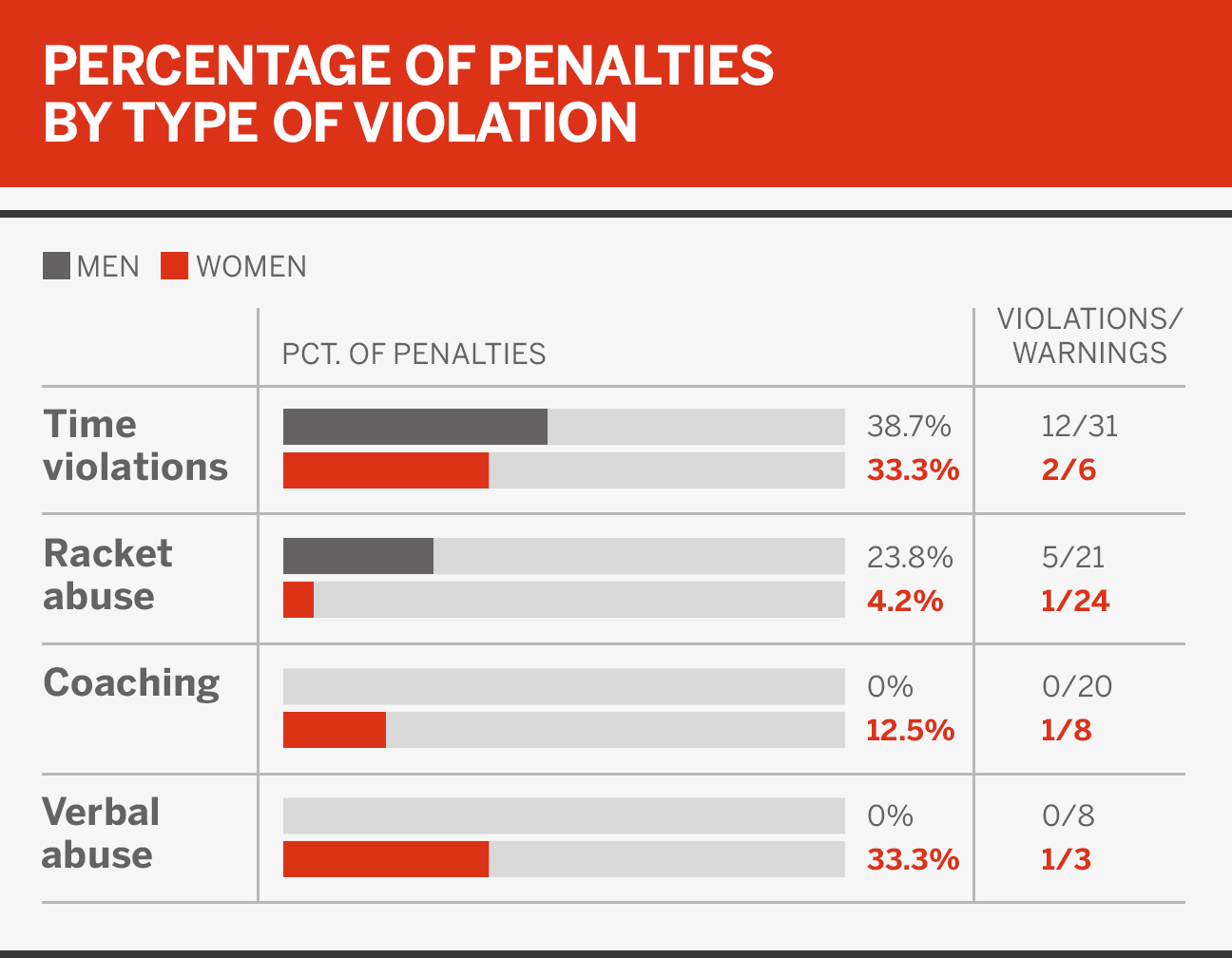In the 2018 US Open women's final, Serena Williams was given a series of three code violations that all but cemented her loss against Naomi Osaka. The first was for coaching, the second (a point penalty) for racket abuse and the third (game penalty), in which Williams was already down a set and 4-3 in the second, for verbal abuse.
In the heat of the moment, Williams had strong words for chair umpire Carlos Ramos: "There are men out here who do a lot worse than me, but because I'm a woman, you are going to take this away from me? That is not right."
The fallout was controversial, to say the least. But the incident led us to wonder: Was there a trend in either direction for men's and women's players?
The USTA, in response to our findings, said in a statement, "One could argue that not all rules, especially as it relates to coaching, were applied consistently throughout the tournament."
We watched 73 matches from the 2018 Grand Slam season in their entirety -- 100 sets of men's tennis and 100 sets of women's tennis. We tracked the number of times the rules were broken, as well as the number of times players were penalized for those infractions.
We could only see what the cameras captured, so we likely weren't able to catch every infraction; but the sample size gave us a strong indication of the rate of penalization for men and women.
In trying to determine which rules were broken, we referred to the Grand Slam Code of Conduct. We subjectively rated infractions on a scale of 1 to 5, with 1 being a less-egregious interpretation of the rules and 5 being an indisputable violation of code.
Here is the scale for the rule that prohibits racket abuse.
Here's the subjective scale for communication with coaches during a match:
For the purposes of this study, incidents scored 3 or higher are considered clear infractions -- and subject to penalty. Of the 90 total infractions for the men in those 100 sets, 48 were clear violations of the rules, while for the women, only 11 of the 40 infractions we found were considered egregious enough to warrant penalty:
The response
As our analysis continued, we sought comment from the United States Tennis Association to get thoughts on the numbers we uncovered.
"The US Open utilizes the best officials in the world, yet we do believe we need to ensure consistent rule applications to all players and all circumstances," said Chris Widmaier, the USTA's managing director of corporate communications. "As you noted in your study the 'numbers don't suggest an inequity between treatment of men's and women's players,' [yet] Serena Williams was not given much leeway."
Coaching
The Grand Slam Code of Conduct states, "Players shall not receive coaching during a match (including the warm-up). Communications of any kind, audible or visible, between a player and coach may be construed as coaching."
During the US Open final, Ramos issued Williams a code violation and warning for receiving coaching from her coach, Patrick Mouratoglou, when he signaled to her to approach the net. That incident started a cascade of events, with Ramos ultimately penalizing Williams a point and a full game for additional code violations.
While coaching is against the rules, we found that the question of whether Williams and Mouratoglou were justified in their anger for the coaching warning had some merit.
In the 200 sets of tennis we analyzed, Williams was the only player to receive an official penalty, which is more eye-opening when you consider how much more coaching we saw in the men's matches we watched.
Williams, on Tuesday at the Australian Open, did not comment when asked about the state of coaching in today's game.
Violations
While the numbers don't suggest an inequity between the treatment of men's and women's players, one thing was clear: Serena Williams was not given much leeway in the US Open final.
Of the eight coaching warnings and three verbal abuse warnings given in the 100 sets of women's tennis we watched, she was the only player penalized, and the infractions couldn't have come at a more crucial time.

Carlos Ramos and Serena Williams
In our analysis, five of Ramos' matches were examined. Putting aside the US Open women's final, which might be seen as an outlier event, Ramos issued only one other penalty in the matches examined. That penalty was a time violation warning against Nikoloz Basilashvili in his fourth-round US Open match against Rafael Nadal.
A look at the data from the other four Ramos matches (Serena Williams was not part of these matches):
Sets umpired: 13.
Penalties issued: 1.
Rate of penalization per set: 7 percent.
As for Williams, here are her numbers from the other six matches we watched from 2018:
Sets: 15.
Penalties issued: 0.
"Again, we need to do our best for consistent application of the rules," Widmaier said. "The inconsistent application of the rules as it relates to coaching is what triggered this series of events."
